Introduction
Byme-A V2.0 is a flight controller applicable to various straight wing aircraft including 3D fixed wing(F3P) and 4-channel trainer and scale model aircraft(excluding V-tail gliders) and is SBUS and PPM signal supported. With the three-axis gyroscope and three-axis acceleration sensor and the full attitude algorithm, control algorithm and digital filter, Byme-A V2.0 makes the flight much easier.
There are six flight modes: Stabilize Mode, Gyro Mode, Acrobat Mode, Manual Mode, Vertical Mode(Multirotor), and Vertical Mode(Fixed Wing).
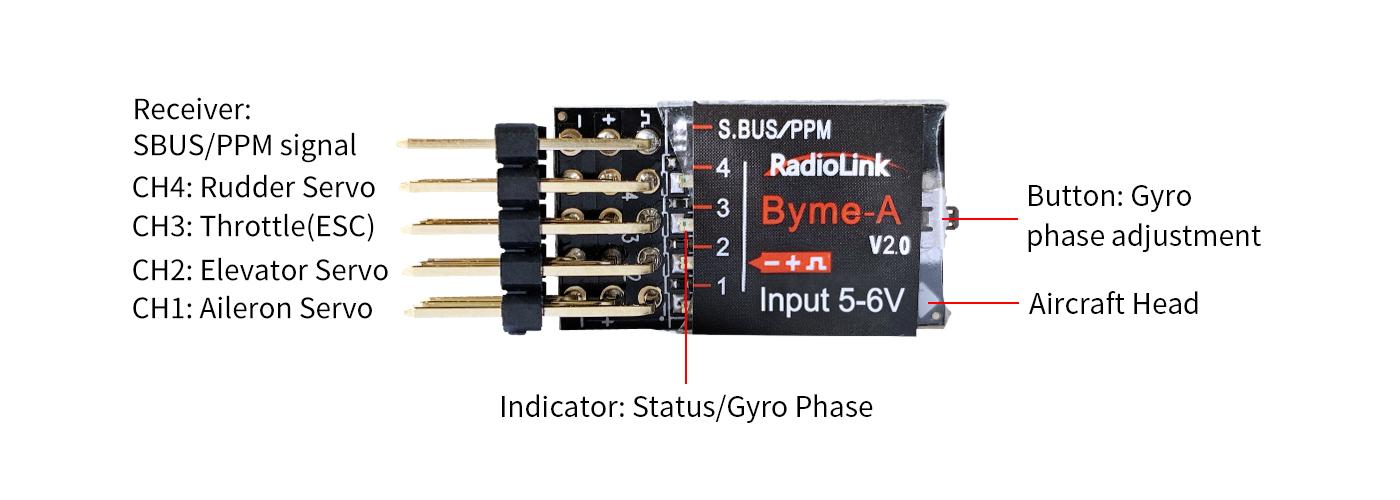
Parameters
Size:35.5*15.5*10.5mm (1.4"*0.61"*0.41")
Weight(With wires):4.5g(0.16oz)
Channel Quantity:4
Integrated Sensor:three-axis gyroscope and three-axis acceleration sensor
Signal Supported:SBUS/PPM
Input Voltage:5-6V
Operating Current:25±2mA
Installation
Make sure the arrow on Byme-A V2.0 points to the aircraft head. The flight controller can be installed either face up or down with 3M glue on the aircraft body (better around the center) and the wires connect to the corresponding pins. Install Byme-A V2.0 as shown below:
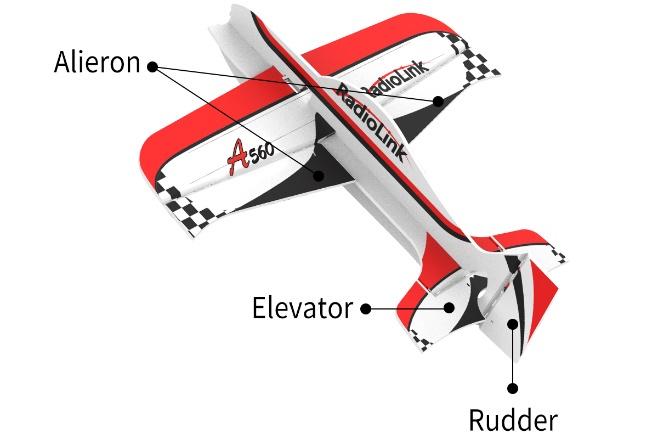
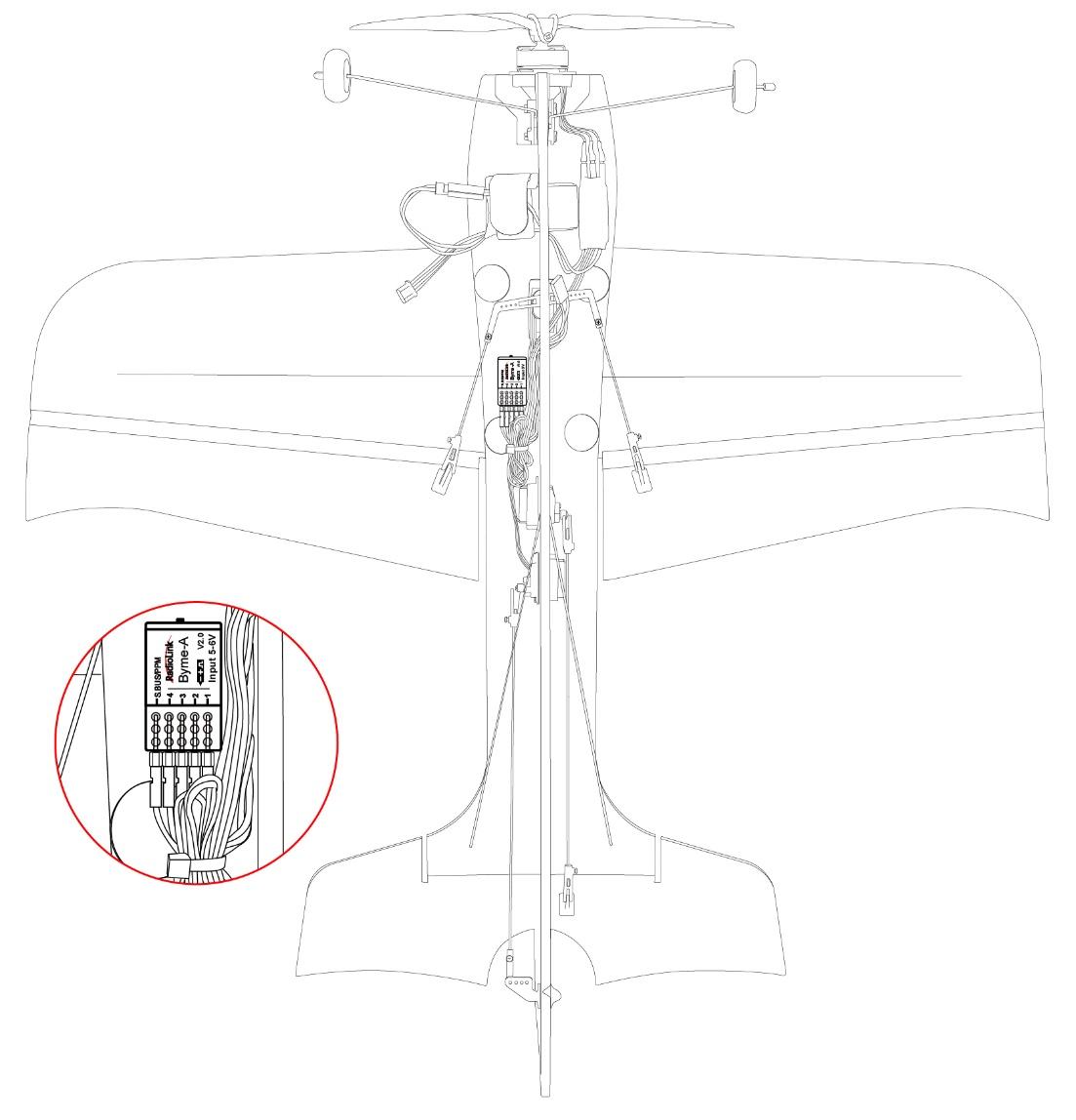
Flight Modes Setup
Flight modes can be set by channel 5 (CH5) and channel 7 (CH7) in the transmitter with six modes: Stabilize Mode, Gyro Mode, Acrobat Mode, Manual Mode, Vertical Mode(Multirotor), and Vertical Mode(Fixed Wing).
※When using the T8S transmitter, the flight mode are switched by CH5(a 3-way switch) and CH7(a 3-way switch) by default. The definition of the flight mode switchover switches is as the picture below:
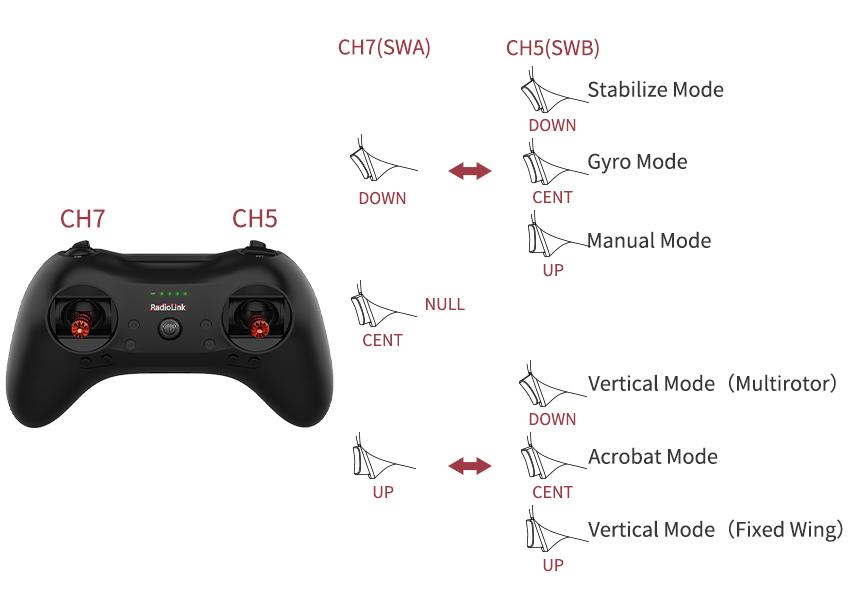
※When using the T8FB transmitter, the flight modes are switched by CH5(a 3-way switch) and CH7(a 2-way switch) by default. The definition of the flight mode switchover switches is as the picture below:
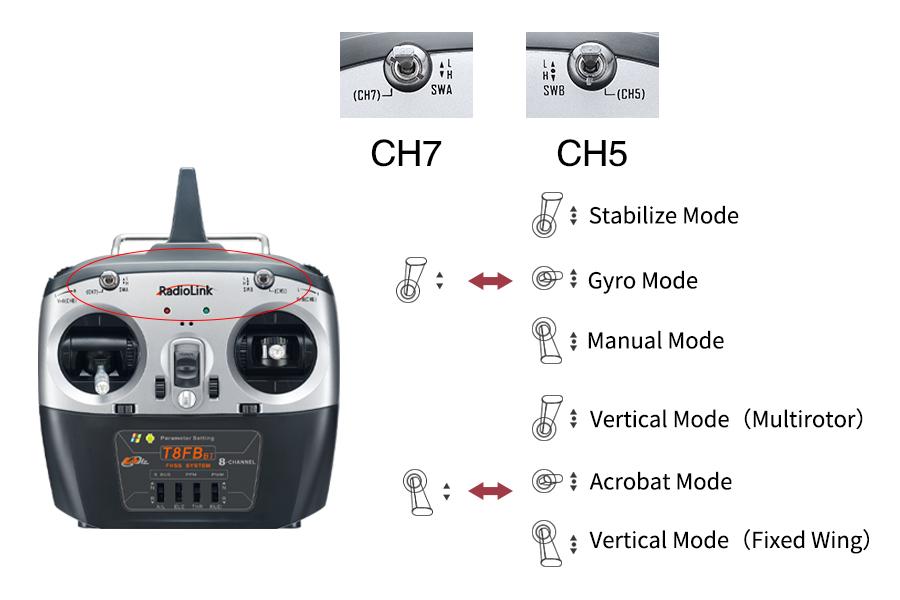
When using other brand transmitters, please refer to the following picture to switch the flight modes. The value range of channel 5 and channel 7 corresponding to the flight mode is as shown below:
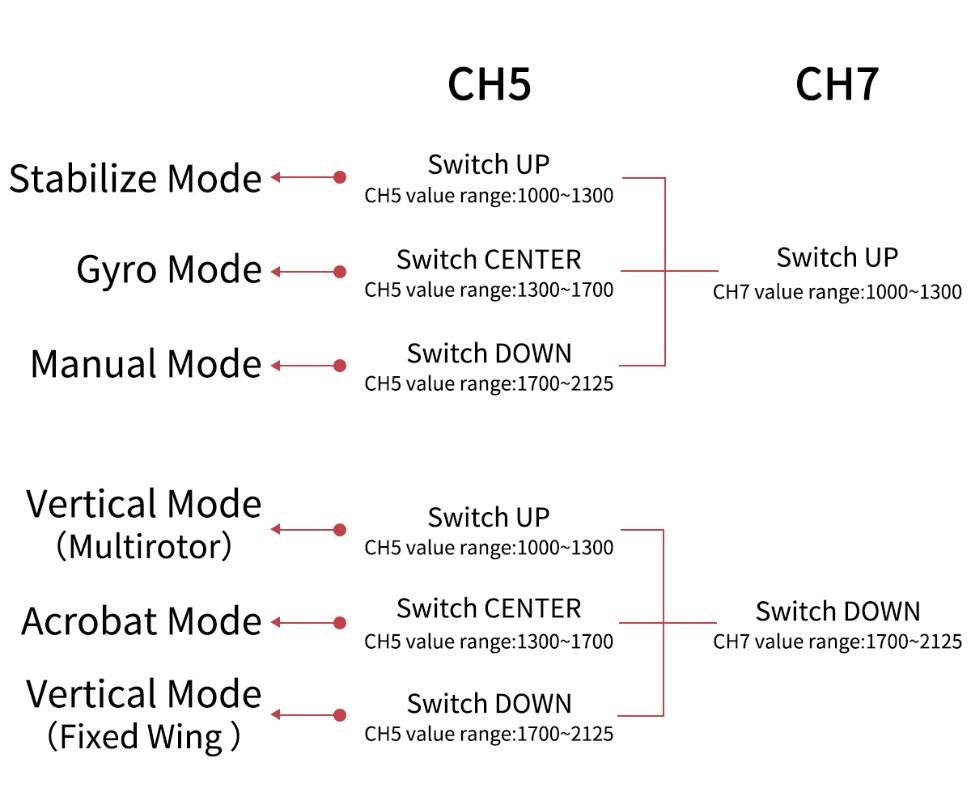
Power-on and Gyro Self-test
(1) Push the throttle stick of the transmitter to the lowest position first, and then power on the aircraft. If the throttle stick is pushed to the highest position and then power on the aircraft, the ESC will enter the calibration mode.
(2) Each time the flight controller is powered on, the gyro of the flight controller will perform self-test with the green LED quickly flashing, which means gyro self-test is under process. Therefore, it is recommended to install the battery first, then place the aircraft on the ground, and then power on the aircraft and put the aircraft still on the ground until DEE sounds from the motor heard. When the green LED is always on means self-test is done.
Attitude Calibration
Flight controller Byme-A V2.0 needs to calibrate the attitudes/level to ensure the balance status.
The aircraft can be placed flat on the ground when performing attitude calibration. It is advised to lift the model head with a certain angle(20 degree is advised) for beginner to ensure the calibration accuracy and attitude calibration will be recorded by flight controller once the it is complete with success.

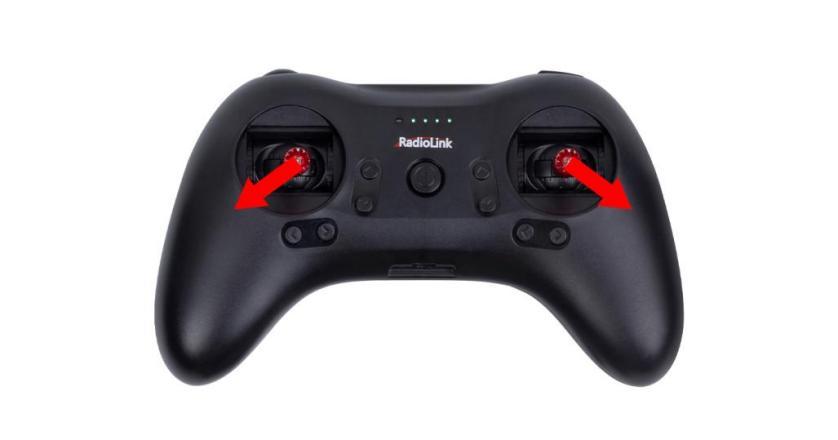 (2) Push the left stick (left and down) and the right stick (right and down) as below and hold more than 3 seconds. The green LED flashes once mean the calibration completed. It is also normal for the control surface to swing or the motor to rotate once at this time.
(2) Push the left stick (left and down) and the right stick (right and down) as below and hold more than 3 seconds. The green LED flashes once mean the calibration completed. It is also normal for the control surface to swing or the motor to rotate once at this time.
Note: When using a non-RadioLink transmitter, if the attitude calibration is unsuccessful when pushing the left stick (left and down) and the right stick (right and down), please change the direction of the channel in the transmitter. Make sure when pushing the joystick as above, the value range of channel 1 to channel 4 is:
CH1 2000 µs, CH2 2000 µs, CH3 1000 µs, CH4 1000 µs
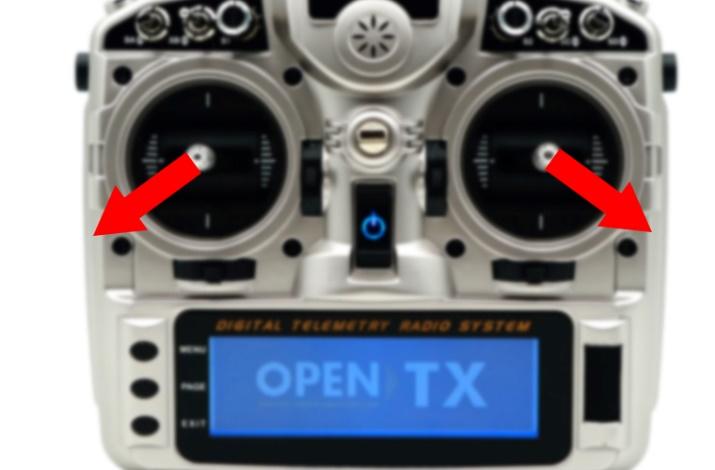
Take an open source transmitter as example. The servo display of channel 1 to channel 4 when calibrating the attitude successfully is as shown below:
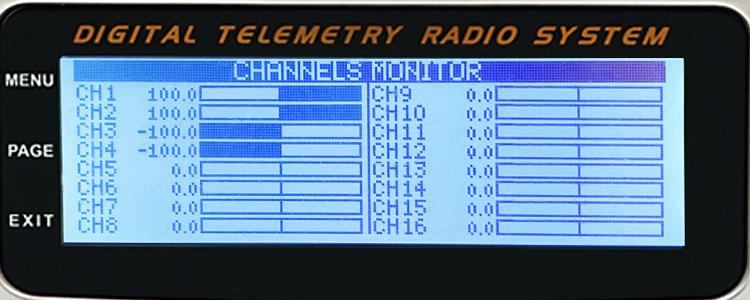
CH1 2000 µs (opentx +100), CH2 2000 µs (opentx +100)
CH3 1000 µs (opentx -100), CH4 1000 µs (opentx -100)
Gyro Phase
Gyro Phase Test
Make sure attitude calibration is done before gyro phase test. Because flight controller will auto identify NOR/REV and modify gyro direction when doing attitude calibration.
At Stabilize Mode, hold the aircraft and simulate the actual flight movement to check the gyro phase of aileron, elevator, and rudder are right or not. There is no need to operate the transmitter when testing the gyro phase. The movement of aileron, elevator, and rudder at Stabilize Mode are opposite to that at Manual Mode because the gyro will help aircraft keep balancing.
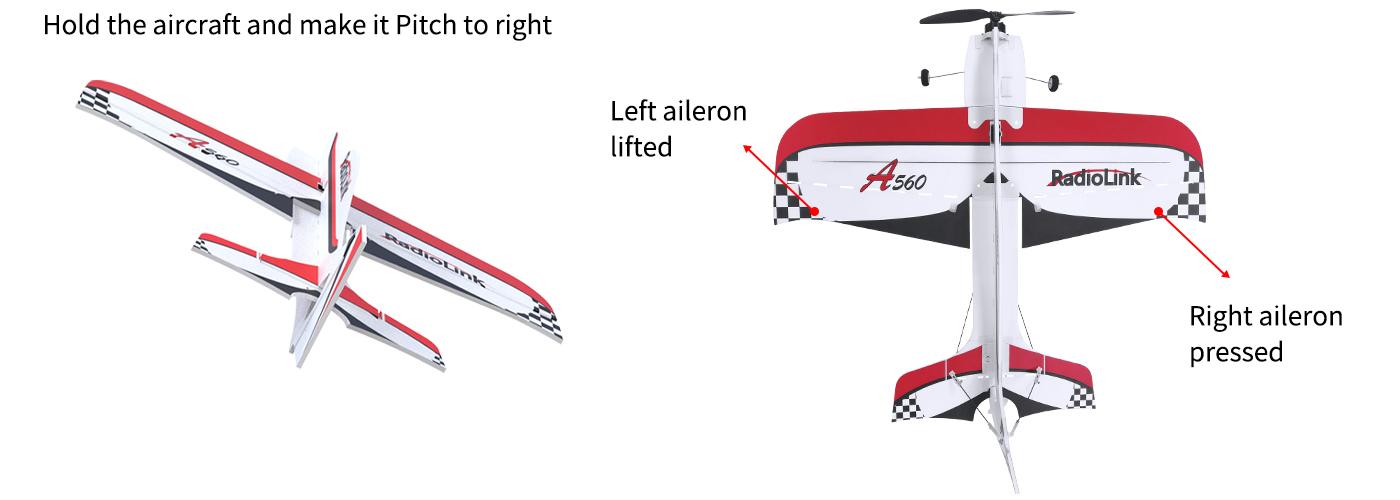
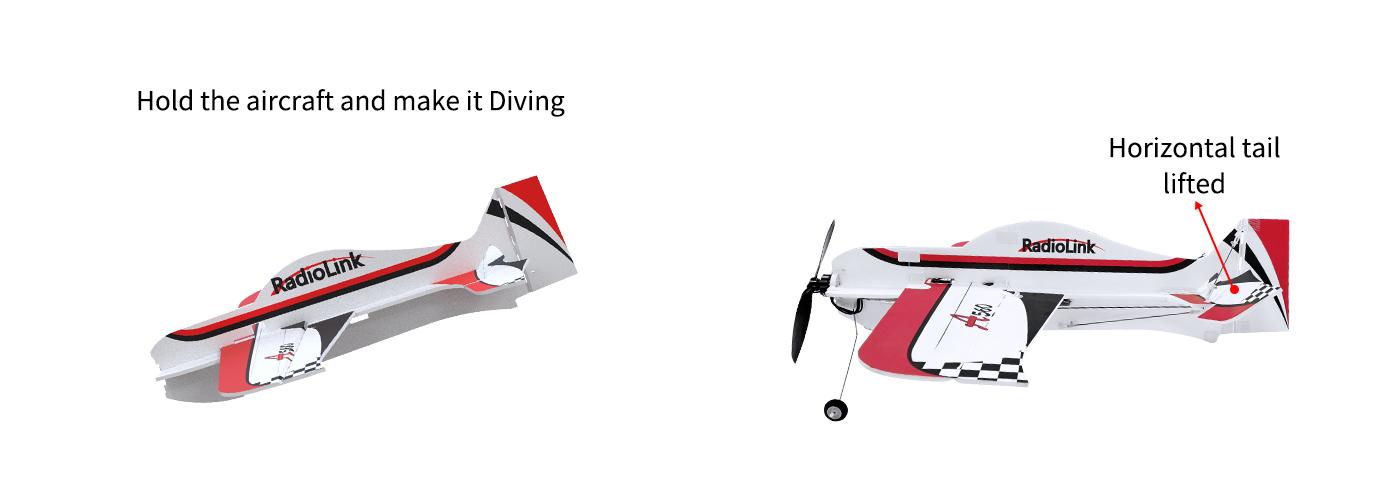
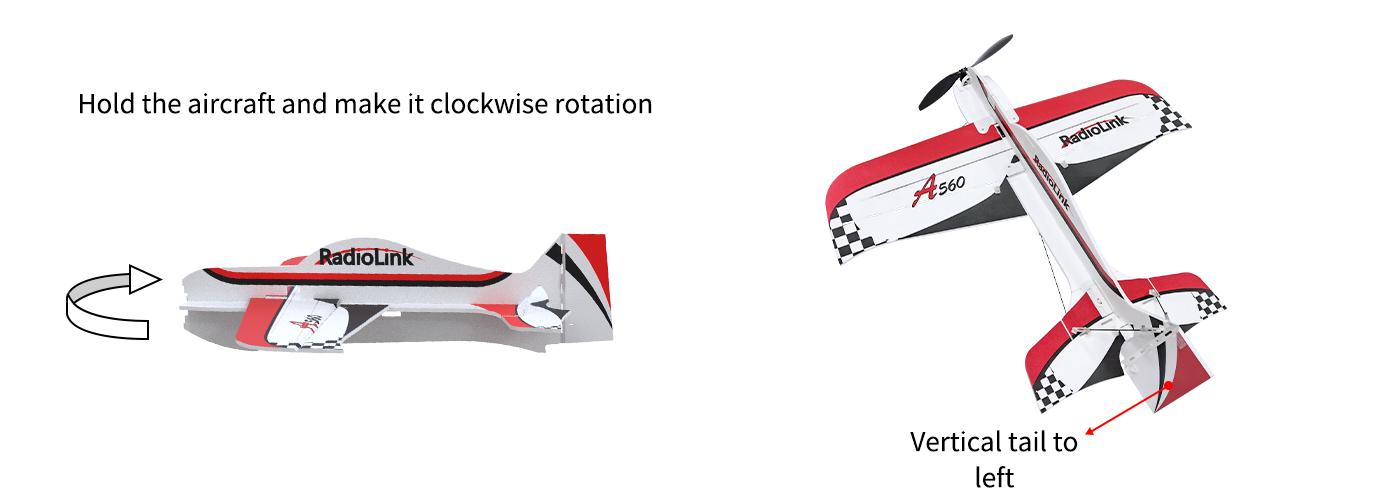
In Stabilize Mode, if the gyro phase is reversed, please adjust the gyro phase by the flight controller Byme-A V2.0. See the below for the adjustment method.
Gyro Phase Adjustment
If gyro phase is reversed, the phase needs to be adjusted by the flight controller. Press the button on the front of the flight controller Byme-A V2.0 to change the gyro phase. The adjustment method is as follows:

No. | Channel | If gyro phase is reversed | Indicator LED |
1 | AIL | Short press the button once | Green LED of CH1 on/off |
2 | ELEV | Short press the button twice | Green LED of CH2 on/off |
3 | THRO | N/A | Green LED always on |
4 | RUDD | Short press the button four times | Green LED of CH4 on/off |
Note : Neither the always-on nor off green LED means reversed phase. Only toggle the joysticks can check if the corresponding servo phases are reversed. If the gyro phase of the flight controller is reversed, adjust the gyro phase by pressing the buttons on the flight controller.
Transmitter Setup
Model Type Setup
Model type needs to be set as fixed wing (Acrobasic) in the transmitter. Take RadioLink AT9S Pro transmitter as example:
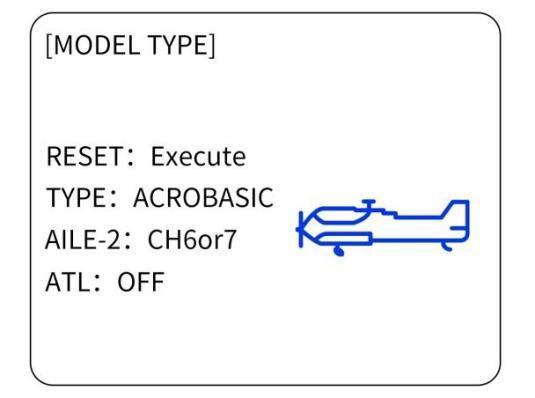
Transmitter Phase Setup
If RadioLink transmitter is used, set transmitter phase:
CH3 - Throttle: Reversed
Other channels: Normal
Note: When using a non-RadioLink transmitter, there is no need to follow this requirement.
Transmitter Phase Test
Make sure the transmitter phases are correct before flight. All the settings will take Mode 2 as example. Please check the transmitter phase at Manual Mode.
At Manual Mode, put the aircraft on the ground and keep horizontal. Check the phase of aileron, elevator, and rudder by pushing the joysticks of transmitter.
Toggle the aileron joystick to left, left aileron is lifted and right one is pressed; toggle the joystick to right, left aileron is pressed and right one is lifted.

Toggle the elevator joystick downward, elevator servo(horizontal tail) is lifted; toggle the joystick upward, elevator servo(horizontal tail) is pressed.

Toggle the rudder joystick to left, rudder servo(vertical tail) turns to left; toggle the joystick to right, rudder servo(vertical tail) turns to right.
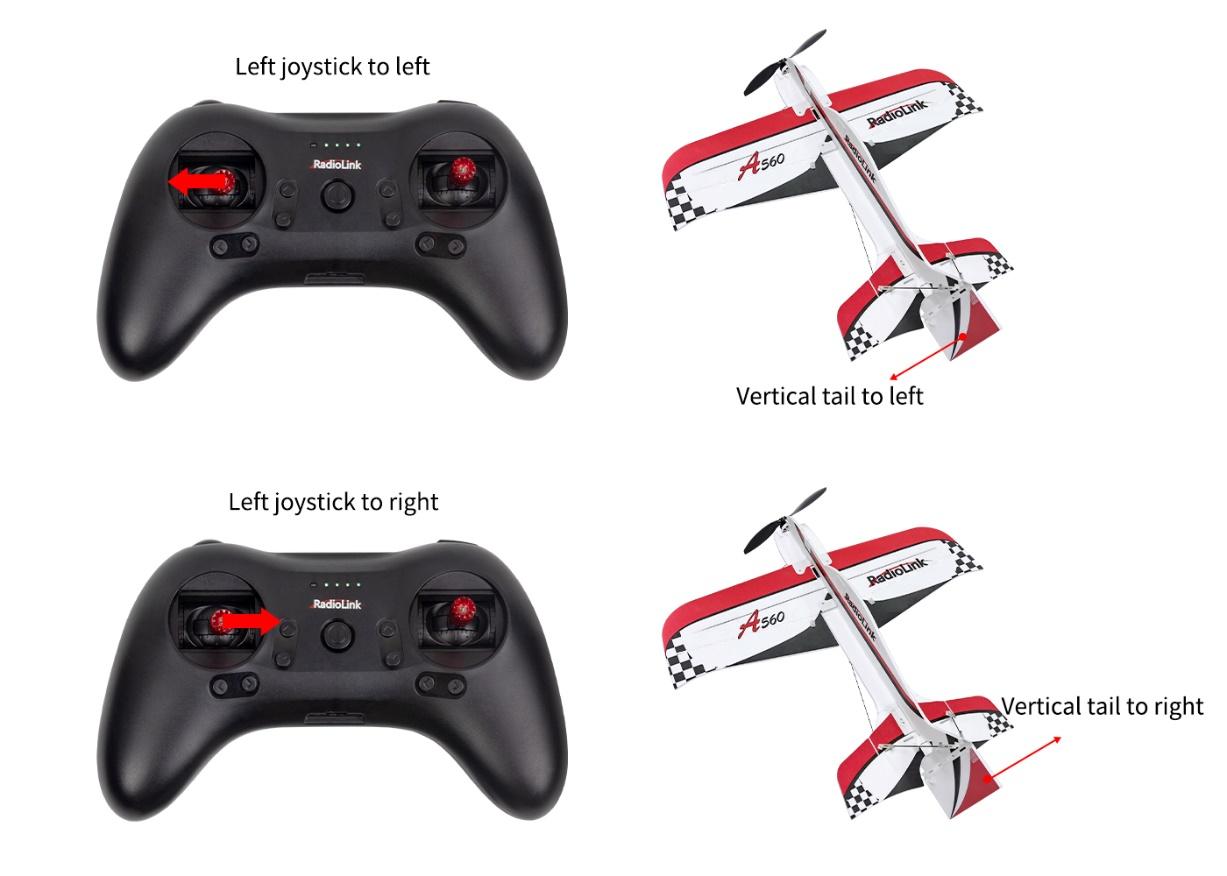
In manual mode, operate the joystick of the transmitter. If the movement of the control surface of the corresponding channel is reversed, enter the setting page of the transmitter to adjust the transmitter phase of the corresponding channel.
Six Flight Modes
All the settings will take Mode 2 as example.
Stabilize Mode
Different form manually control, Stabilize Mode with flight controller balancing, is suitable for beginners to practice level flight.
The model attitude (inclination angles) is controlled by joysticks. When the joystick is back to central point, the aircraft will level. The max inclination angle is 70° for rolling while that for pitching is 45°.
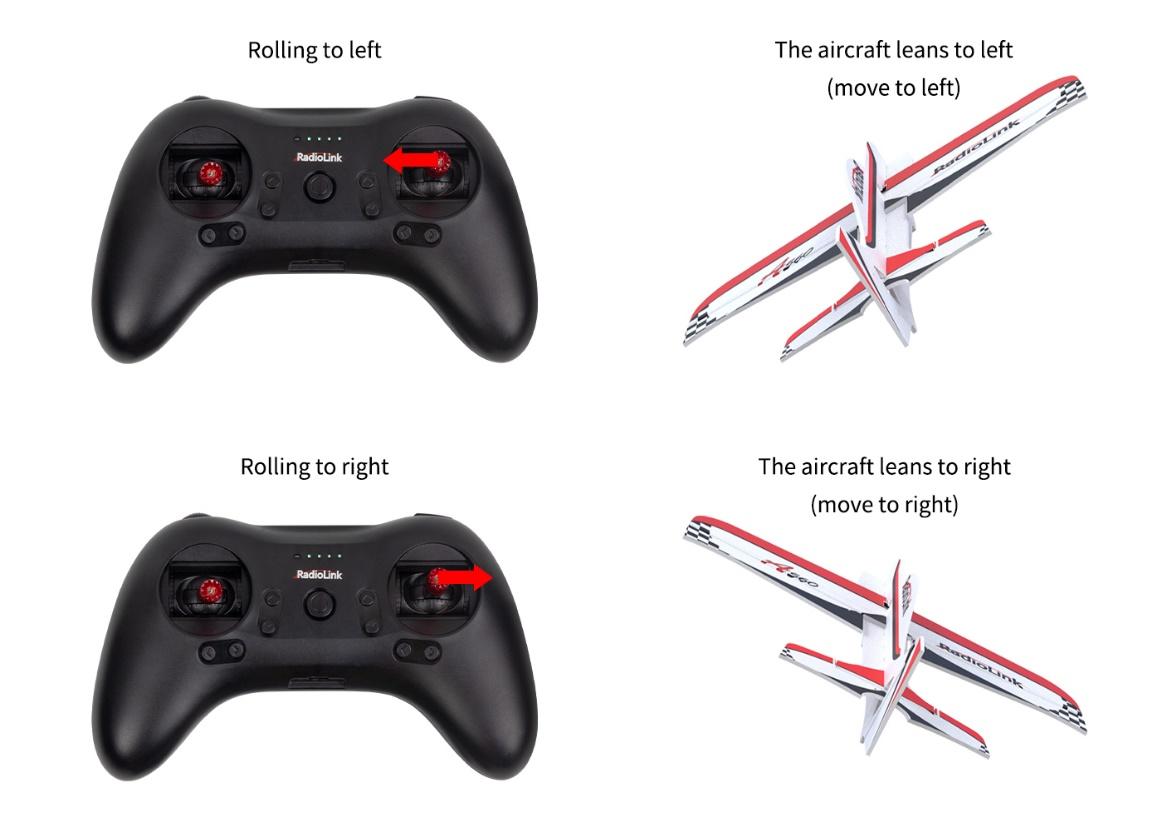
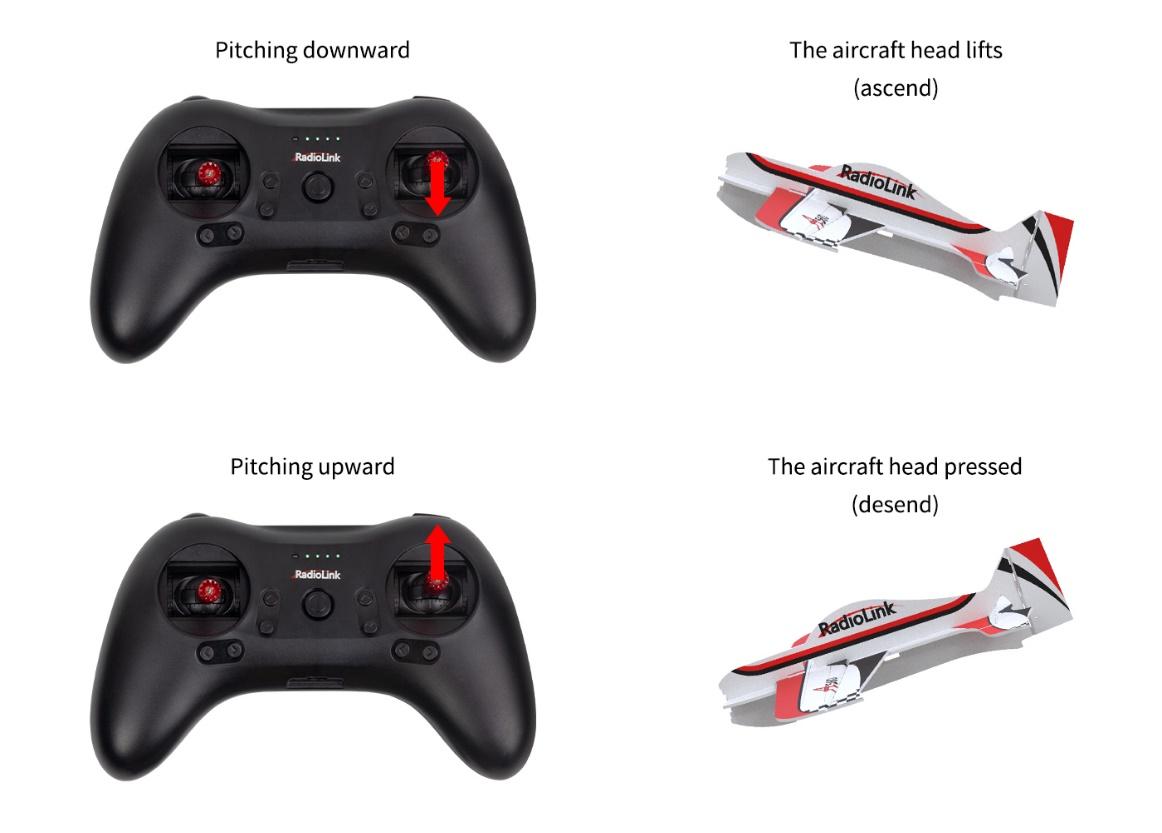
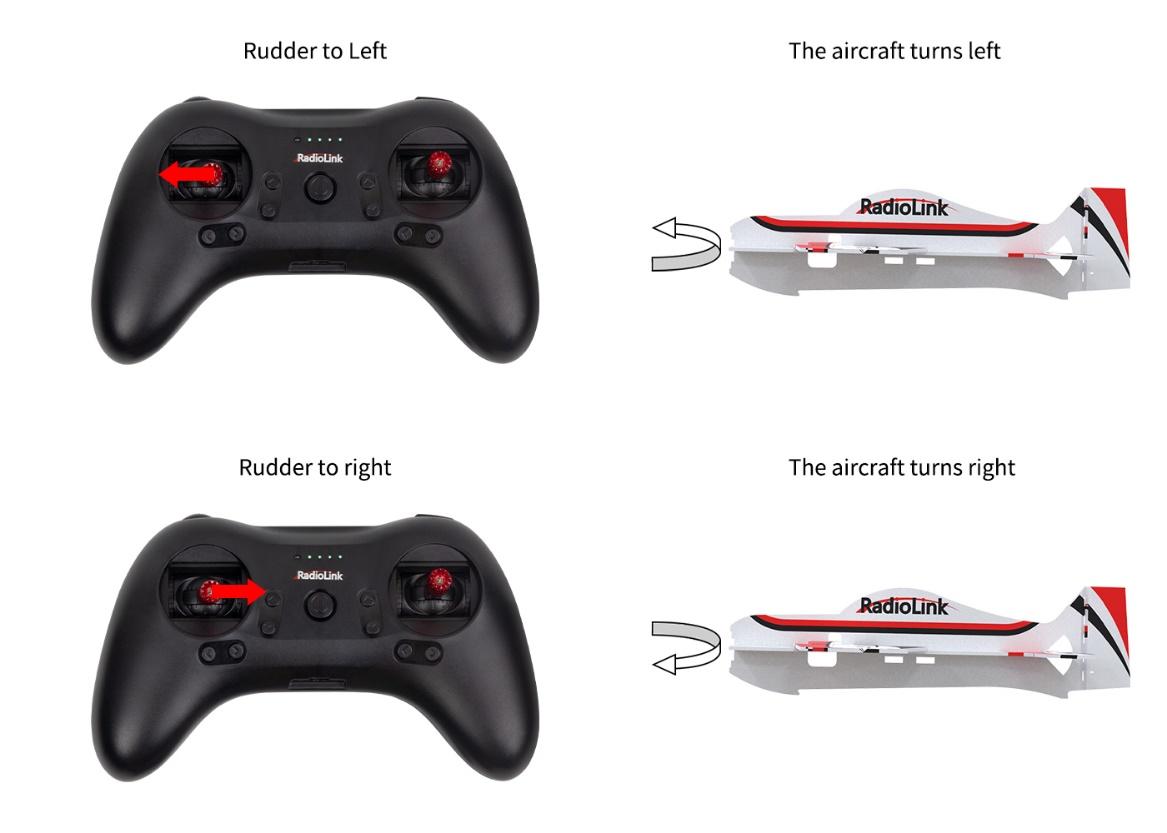
If the throttle is toggled upward, the aircraft accelerate. If toggled downward, the aircraft decelerate.
Vertical Mode (Multirotor)
At Vertical Mode (Multirotor), the aircraft will remain vertical posture and direction. The joystick operation is same as that of multi-rotors.
The altitude algorithm of Byme-A V2.0 maps the joystick operation onto horizontal ordinates and takes control of full altitude.
Below is the picture illustration with Mode 2 as example. When the aircraft is vertical, toggle the aileron joystick(CH1) to control the aircraft moving left or right.
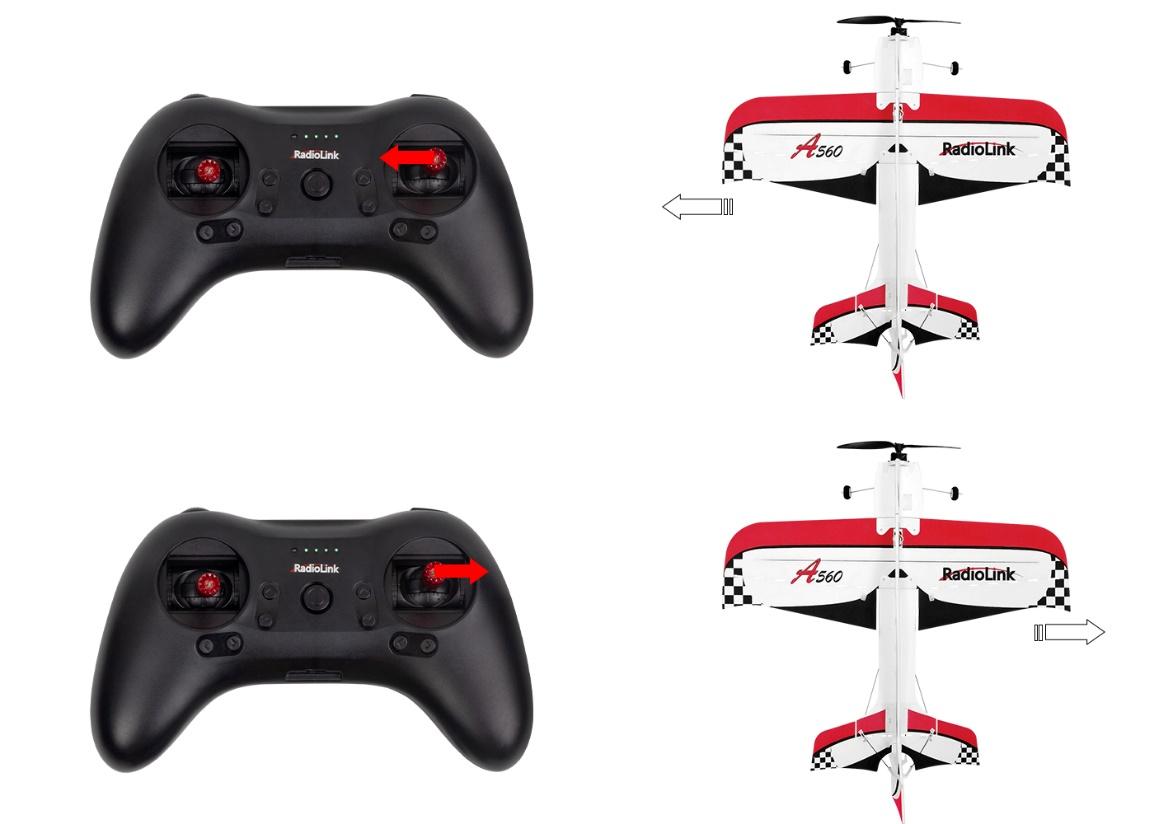
When the aircraft is vertical, toggle the elevator joystick(CH2) to control the aircraft moving forward or backward.
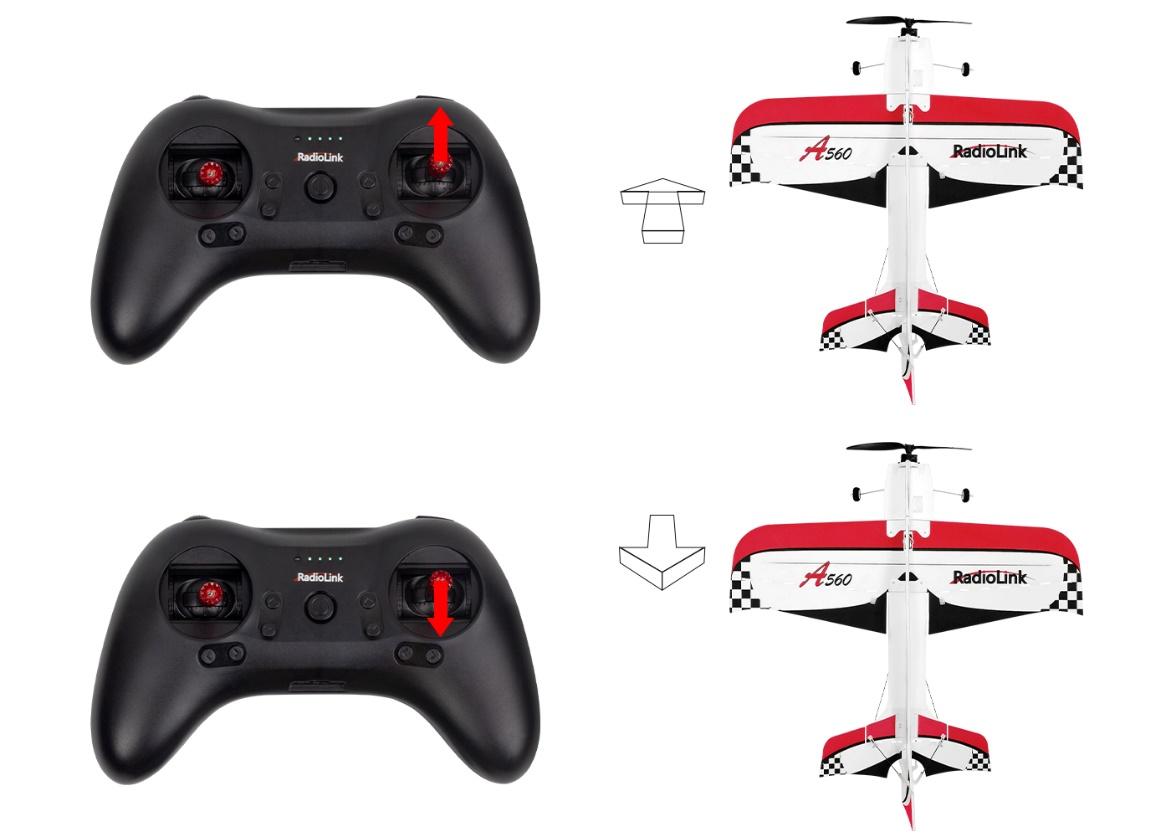
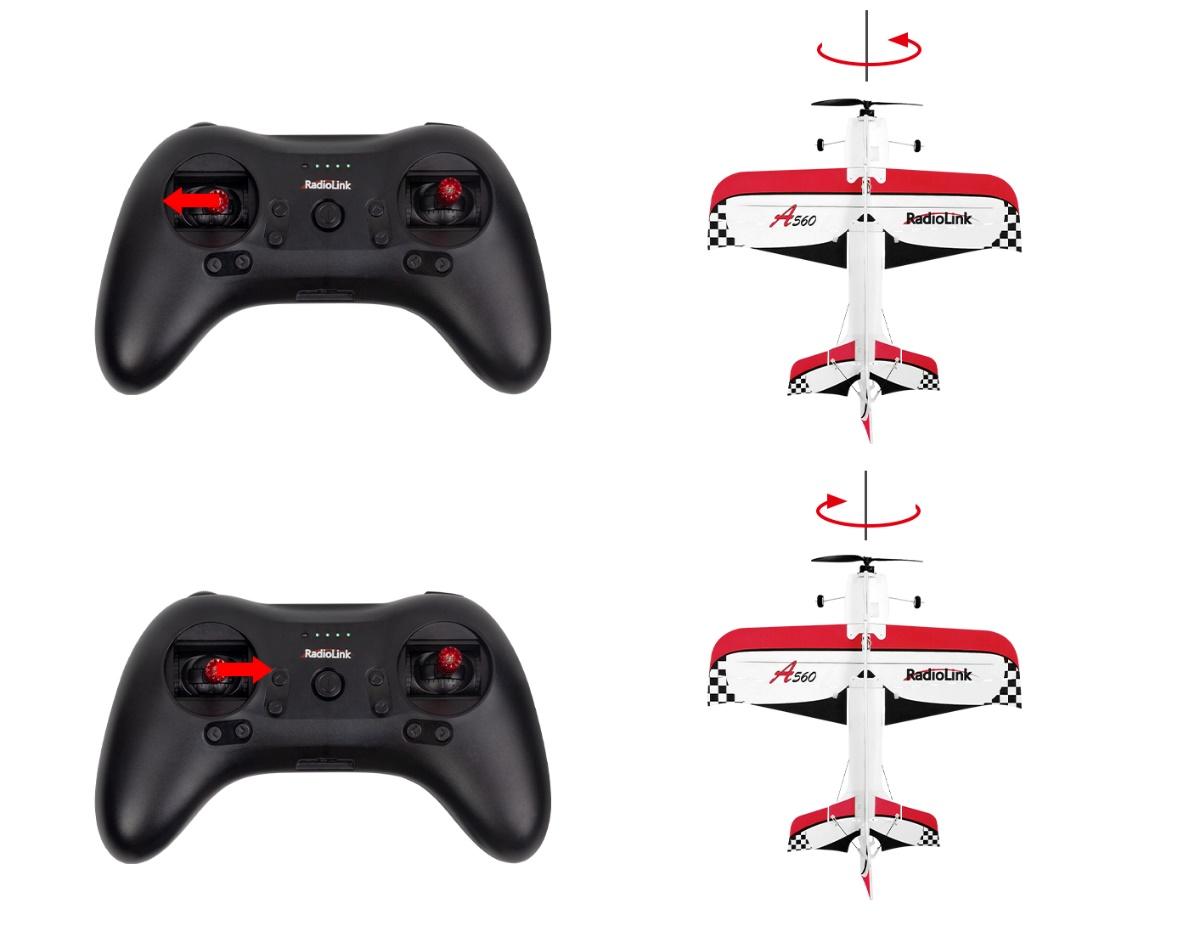 When the aircraft is vertical, toggle the rudder joystick(CH4) to control the aircraft moving (anti)clockwise.
When the aircraft is vertical, toggle the rudder joystick(CH4) to control the aircraft moving (anti)clockwise.
If the throttle joystick is toggled upward, the aircraft climbs upwards at a vertical attitude. If toggled downward, the aircraft descends at a vertical attitude.
Vertical Mode (Fixed Wing)
At Vertical Mode (Fixed Wing), the aircraft will remain vertical posture and direction.
The altitude algorithm of Byme-A V2.0 maps the joystick operation onto horizontal ordinates and takes control of full altitude.
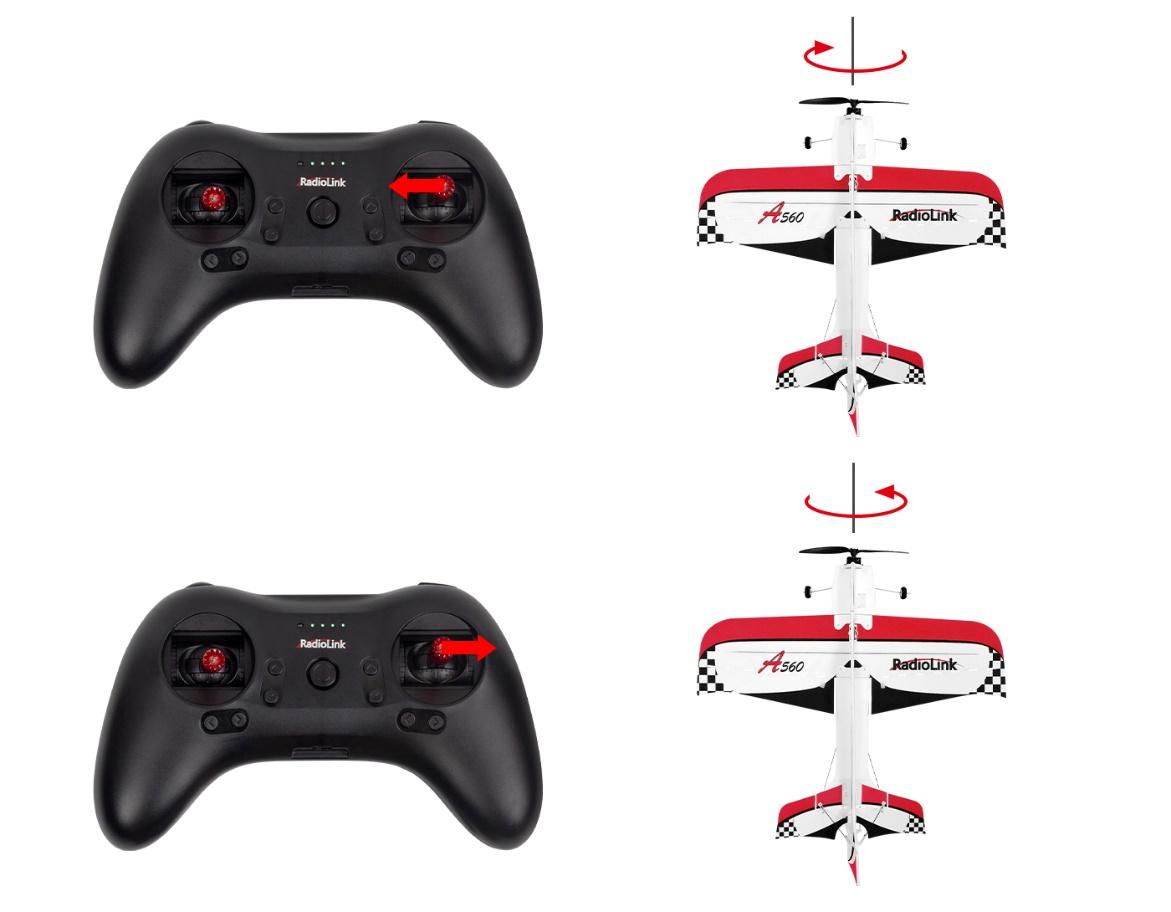 Below is the picture illustration with Mode 2 as example. When the aircraft is vertical, toggle the aileron joystick(CH1) to control the aircraft moving (anti)clockwise.
Below is the picture illustration with Mode 2 as example. When the aircraft is vertical, toggle the aileron joystick(CH1) to control the aircraft moving (anti)clockwise.
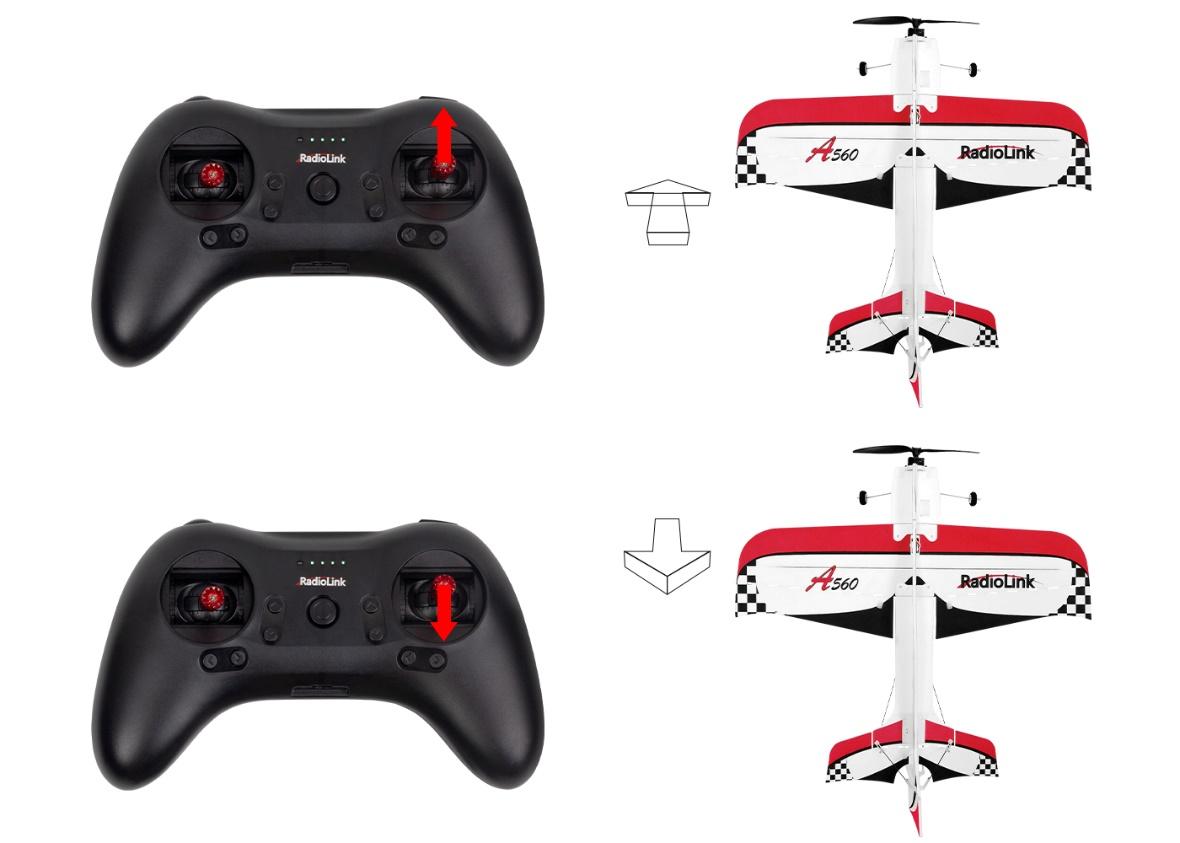 When the aircraft is vertical, toggle the elevator joystick(CH2) to control the aircraft moving forward or backward.
When the aircraft is vertical, toggle the elevator joystick(CH2) to control the aircraft moving forward or backward.
When the aircraft is vertical, toggle the rudder joystick(CH4) to control the aircraft moving left or right.
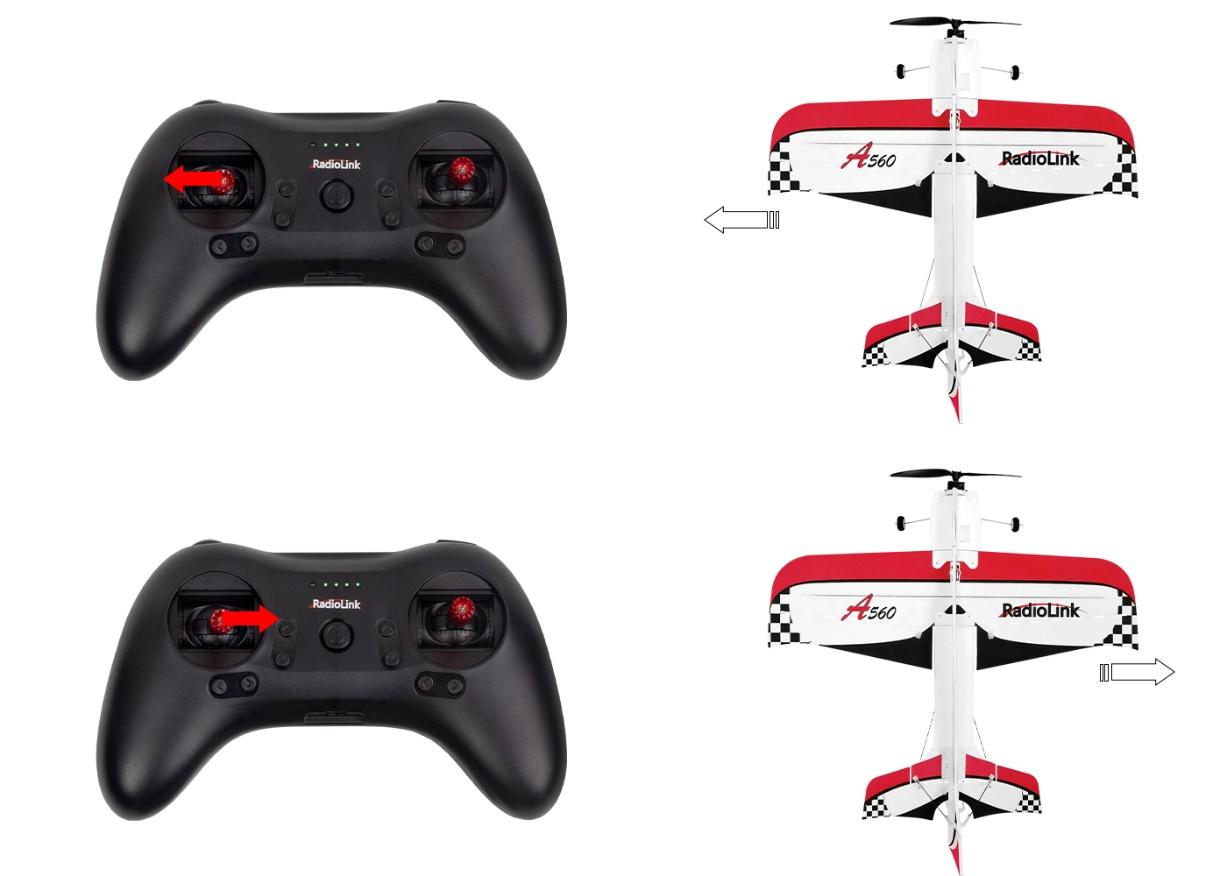
If the throttle joystick is toggled upward, the aircraft climbs upwards at a vertical attitude. If toggled downward, the aircraft descends at a vertical attitude.
Gyro Mode
At this more advanced mode, the integrated three-axis gyro assists to increase the stability. But the aircraft won’t level even the joystick is back to central point. The joystick control the rotation(angle speed) of the aircraft. That is, when rolling, pitching or rudder joystick is toggled, the aircraft will rotate with the corresponding speed.
Acrobat Mode
Combination of Stabilize Mode and Gyro Mode makes it easy to realize various free styles such as rolling, rapid pitching, backward, side flight and spiral descending.
the aircraft will level when the joystick is back to central point. If the joystick is toggled with small range, the aircraft will move to the corresponding directions.
When toggle joysticks with large range, aircraft will rotate to the corresponding directions.
Manual Mode
No assistance from flight controller algorithm or gyro, all flight movements are realized manually, which requires the most advanced skills. In Manual mode, it is normal that there is no movement of the control surface without any operation on the transmitter because there is no gyroscope involved in stabilize mode.
Note: In Stabilize/Gyro/Acrobat mode, the aileron may swing by itself to assist the balance due to the gyroscope involved in stabilization, which is a normal phenomenon.
Gyro Sensitivity
There is certain stability margin for the Byme-A V2.0 PID control. For different models, if Byme-A V2.0 under correct or over correct, pilots can try adjusting the rudder angle.